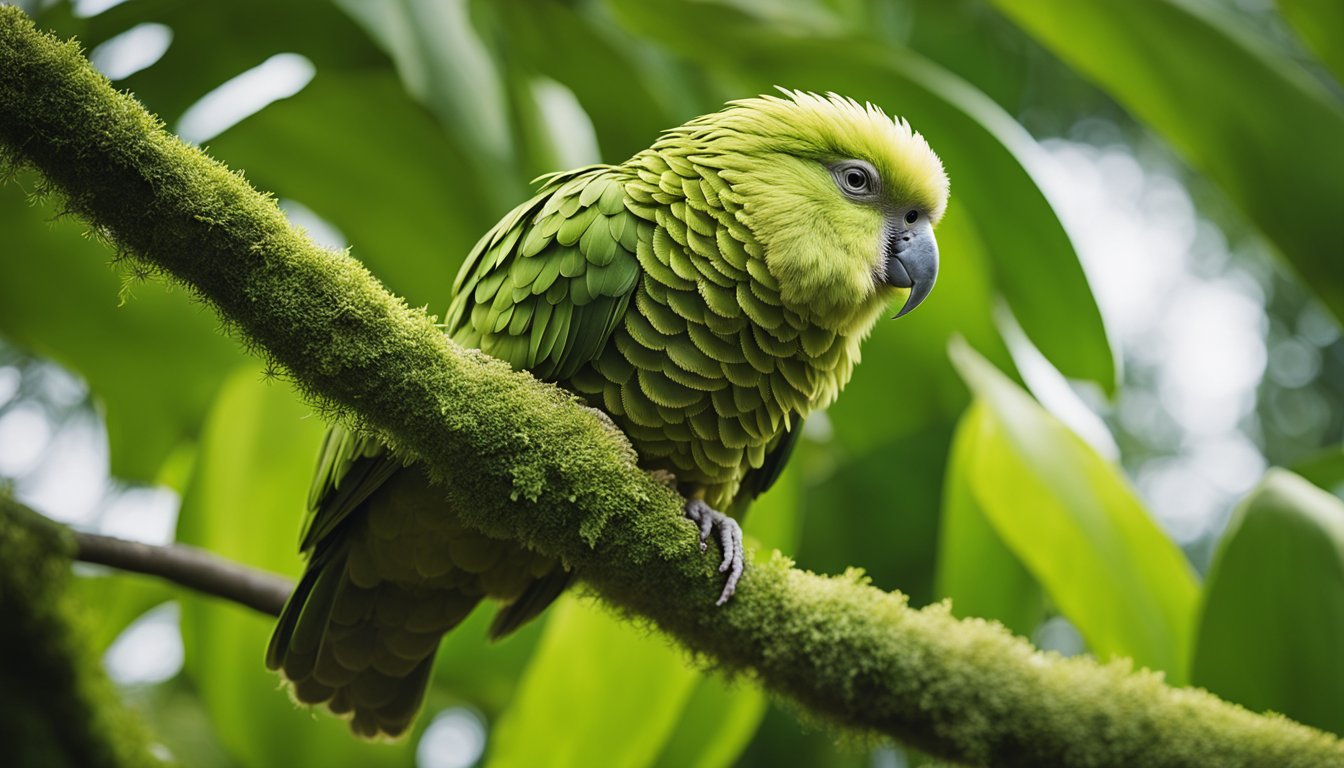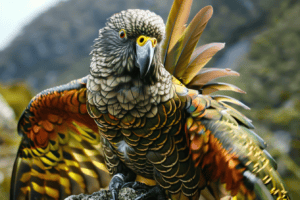Imagine a bird so unique that it defies almost every rule we know about parrots.
Meet the kakapo, a chubby, nocturnal parrot from New Zealand that has captured hearts around the world with its odd characteristics.
Unlike its colorful cousins who soar through the skies, the kakapo is flightless, preferring to walk the forest floor with a waddling gait that’s as endearing as it is unusual.

Getting to know this feathery friend is like stepping into a storybook where the characters are as peculiar as they are charming.
The kakapo’s moss-green feathers blend into the lush New Zealand bush, a perfect camouflage for a bird that’s more at home on the ground than in the air.
But don’t let their unusual looks fool you; kakapos are full of surprises, from their ability to accumulate large amounts of fat before the breeding season to their strong, capable legs which make them excellent climbers.
Key Takeaways
- The kakapo is a flightless parrot indigenous to New Zealand, known for its unique characteristics.
- These birds play a crucial role in the biodiversity of their habitat but are now critically endangered.
- Protecting the kakapo involves understanding their behavior and supporting conservation efforts.
The Life and Times of the Kakapo

Kakapos are more than just birds; they’re a glimpse into a world of wonder.
As we explore the life of these unique parrots, we’ll discover their unusual habits and the special place they hold in the wild.
A Rare Bird Indeed
Did you know that kakapos are one of the rarest birds on our planet?
This critically endangered parrot is a resident of New Zealand and there aren’t many left.
Their rarity is due to a mix of factors, but mainly because humans brought new predators to their home.
It’s our job now to help protect them and boost their numbers through conservation efforts.
Habitat and Diet: What Does a Kakapo Eat?
Kakapos make their homes in forests and scrublands, loving the feel of solid earth beneath their strong legs.
They are not picky eaters, feasting mainly on native plants, fruits, and seeds that they find in the habitat.
They’ve got no need for takeout when they’ve got New Zealand’s finest buffet right at their wingtips!
Kakapo Characteristics: From Nose to Tail
These parrots are a wonder of nature. Imagine a bird that’s a mix between a fluffy owl and a cuddly green teddy bear!
That’s our kakapo for you, with soft feathers predominantly mossy green with a blend of yellow and black.
They might have wings, but don’t expect to see them fly; instead, they’re excellent climbers, thanks to their strong legs.
And those whiskers? They’re not just for looks; they give kakapos a superb sense of smell at night.
The Nightly Adventures of a Nocturnal Parrot
When the sun goes down, the kakapo wakes up.
Yes, you heard it right: they are nocturnal, or in other words, they love the night life!
Males perform a deep, booming mating call, hoping to attract females.
This is part of what’s known as a lek breeding system, where males display in a certain area to win the favor of the females.
Meanwhile, the females raise the chicks all by themselves, often nesting on the ground which is quite unusual for a bird.
They’ll lay 1 to 4 eggs per breeding season, each one a little beacon of hope for the future of their species.
Threats and Conservation: The Fight to Save the Kakapo

Imagine a world where we can hear the deep, resonant “boom” of the kākāpō across the lush forests of New Zealand once more!
That’s what the passionate teams of conservationists are working toward, overcoming tough challenges to protect the kākāpō from the brink of extinction.
Historical Challenges and the Path to Recovery
Before humans arrived in New Zealand, the kākāpō population was thriving.
But with the arrival of European settlers came new, invasive predators like cats, rats, and stoats, which the kākāpō had no natural defenses against.
The introduction of these predators, combined with habitat destruction, meant the kākāpō numbers dwindled alarmingly.
Here’s an inspiring bit of history: The Kakapo Recovery Program began a significant battle against extinction.
Backed by the New Zealand Department of Conservation, the program uses science and conservation techniques, including GPS tracking, to monitor these precious birds and ensure that their numbers are moving in the right direction—up!
Predators and Protectors: Who’s a Friend, Who’s a Foe?
Predators like cats, rats, stoats, and sometimes dogs, have given us quite the challenge.
These animals are not evil; they’re just doing what comes naturally. But, for our feathered friends, they’re the bad guys.
We’ve come up with some creative solutions, though! We’ve turned some islands into special, predator-free zones.
These predator-free islands are like safe playrooms where kākāpō can roam, play, and breed without fear. And it’s working!
Thanks to these safe havens, and our careful monitoring, we’re seeing more kākāpō chicks hatch every year.
For more cool details on efforts to save these quirky birds, check out the resources from the Department of Conservation on Kākāpō Recovery.
It’s a real-life adventure story where we all have a role to play. Isn’t that amazing?
Frequently Asked Questions

Let’s embark on a fun-filled journey to discover some truly fascinating tidbits about the kakapo, our nocturnal parrot pal.
Through some common curiosities, we’ll explore what makes the kakapo stand out in the avian world and learn how we can contribute to their future.
What makes the kakapo a unique bird among our feathered friends?
The kakapo is an extraordinary parrot because it’s the world’s only flightless one, with a hefty build making it the heaviest parrot on the planet.
Plus, it’s quite the night owl, preferring to wander under the moon’s glow rather than bask in the sunshine.
Can you guess what a kakapo’s favorite snacks are in the wild?
Kakapos are quite the gourmands, they adore munching on plants, seeds, fruits, and even the sapwood of certain trees.
They have a particular fondness for the rimu fruit, which is crucial for breeding.
Have you ever wondered how long a kakapo can live?
These green, owl-faced cuties are known for their impressive longevity, often living several decades, with some birds reaching up to 60 years or more.
Their slow lifestyle might just be their secret to a lengthy life.
Where do these adorable, waddling kakapo birds call home?
Kakapos are only found in New Zealand, and they prefer to live on predator-free islands that offer a safe haven, where they can waddle around without a worry and do their signature side-step dance.
Just how big do kakapos get when they’re fully grown?
When fully grown, adult kakapos can be quite sizable, measuring usually between 58 to 64 centimeters in length, a stature that helps them store up all the energy they need to thrive on the ground instead of the sky.
Are there many kakapos left in the world, and what can we do to help them?
Unfortunately, kakapos are critically endangered, with only a few individuals remaining.
We can help them by supporting conservation programs and spreading the word about these feathery wonders to ensure their protection and boost their numbers.









